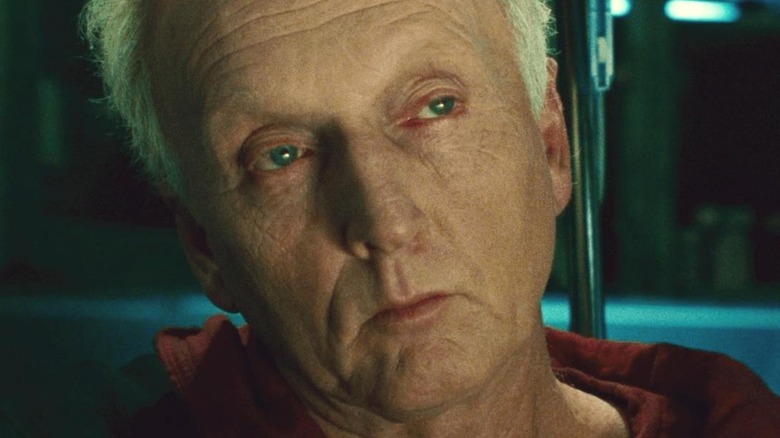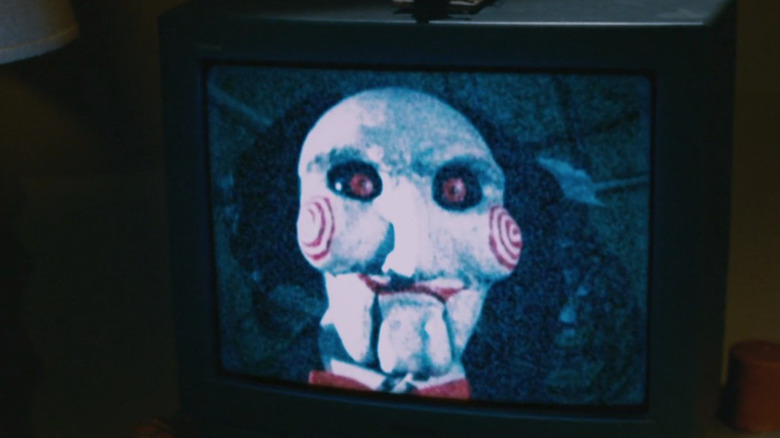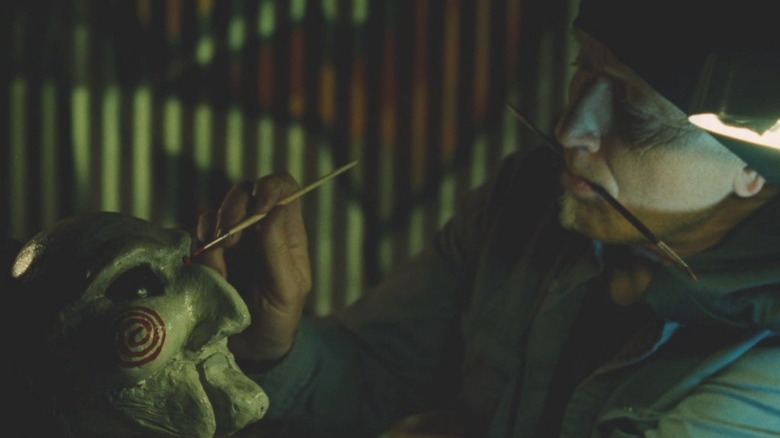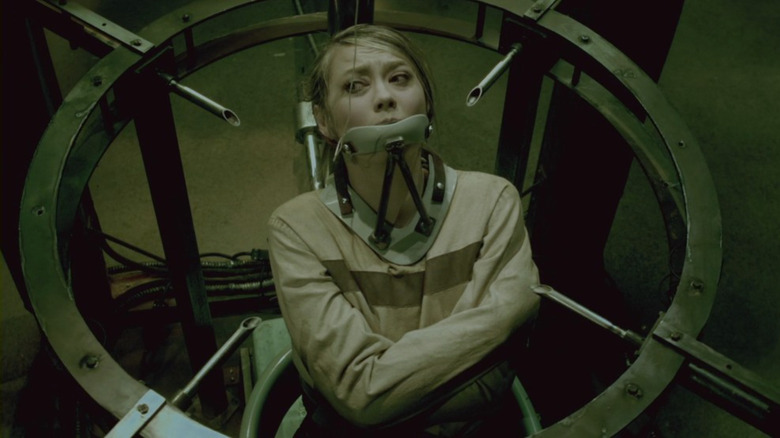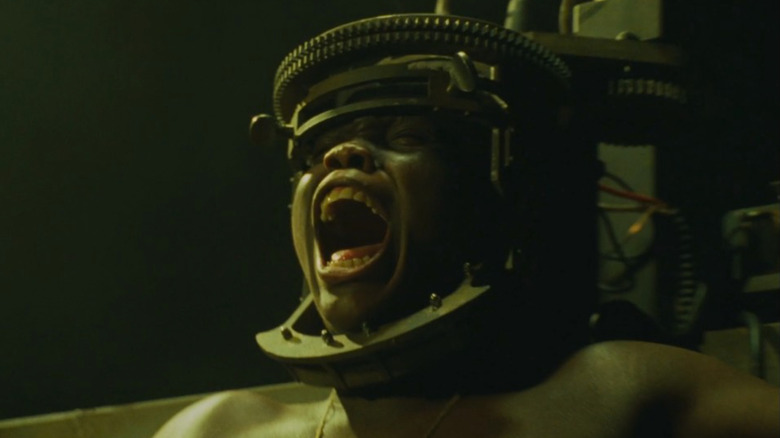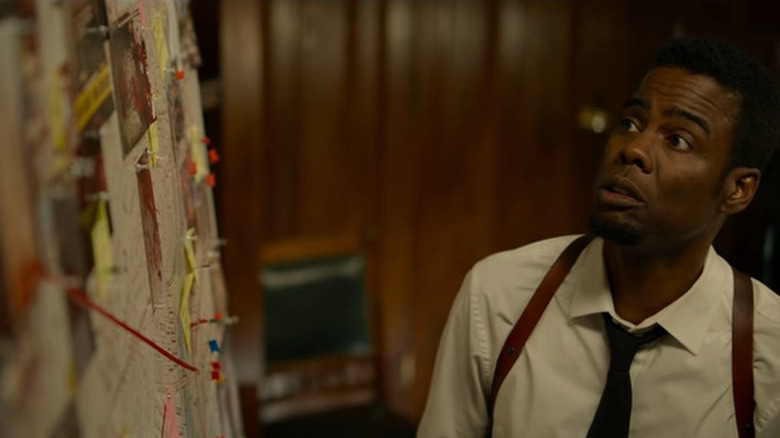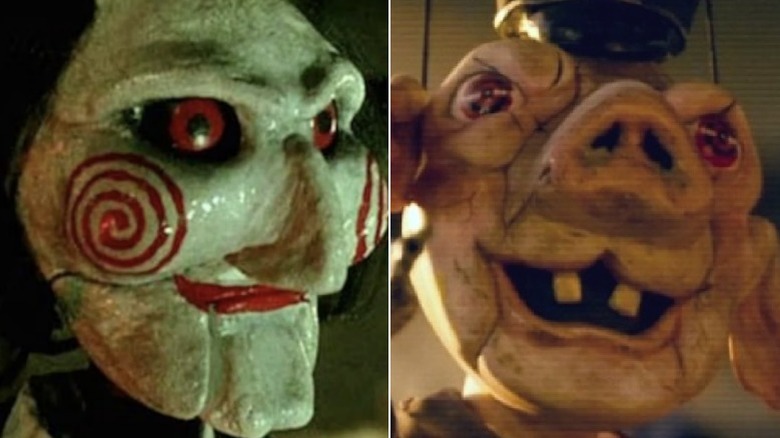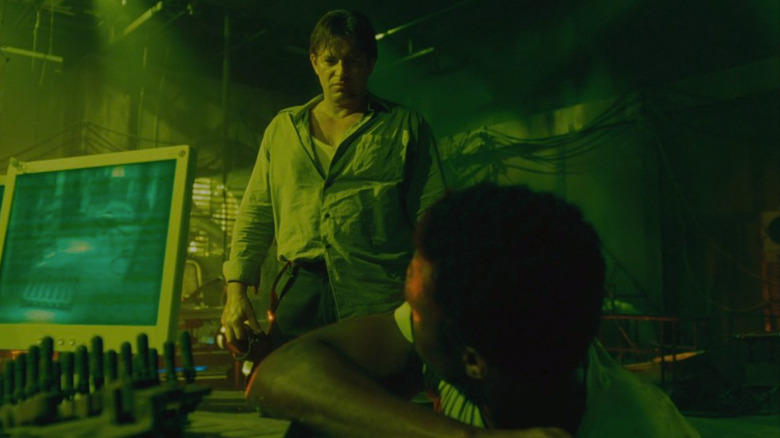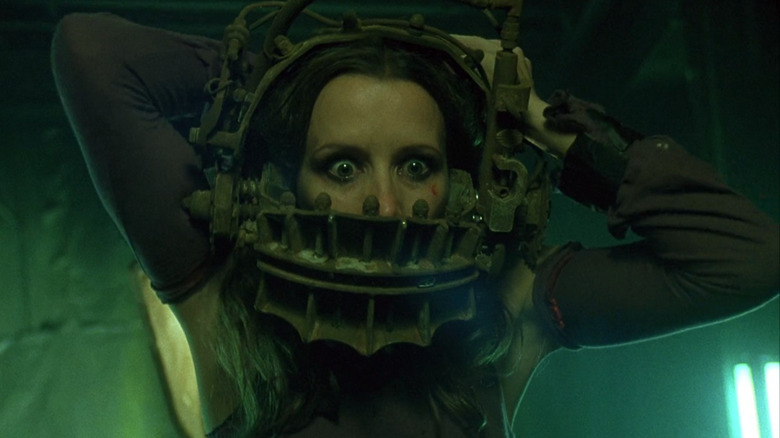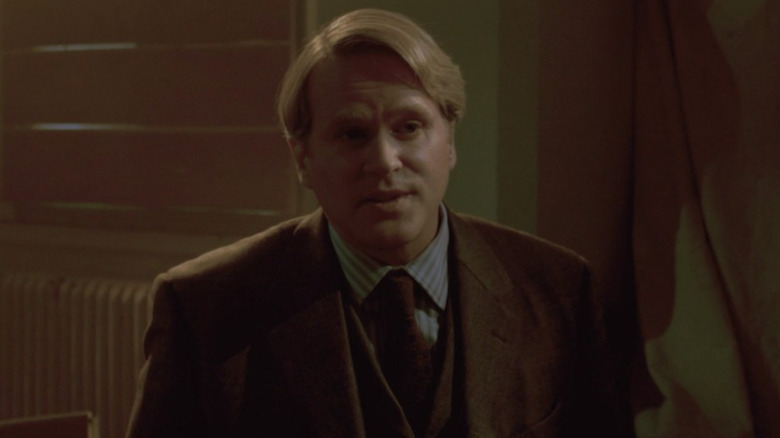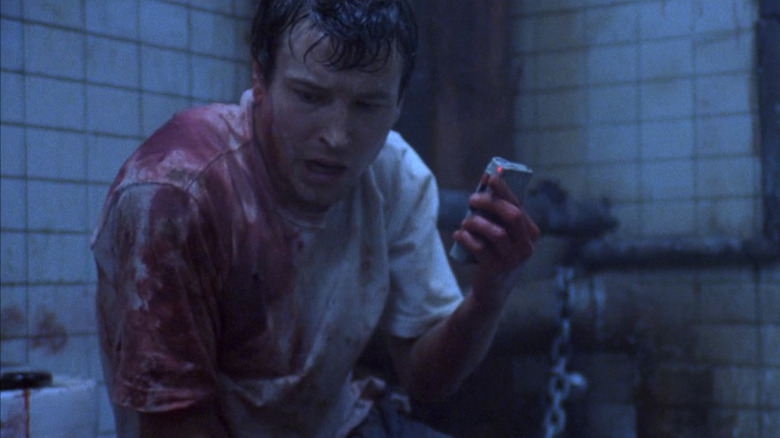Things That Happen In Every Saw Movie
2004 saw the theatrical release of "Saw," a low-budget horror film from young Australian filmmakers James Wan and Leigh Whannell. After graduating from film school, the pair set out to make a cheap first feature that was largely based around a single location. The result was a massive success, earning more than $103 million worldwide on a production budget of just $1.2 million. Fans were hungry for more, and the film's distributor, Lionsgate, was very happy to oblige. For the next six years in a row, audiences knew they would be able to anticipate a new "Saw" sequel every October. While Wan and Whannell have since moved on to other wildly profitable ventures, the series has endured.
With the recent announcement of a new "Saw" installment arriving in October 2023, the series will have managed to produce a total of 10 films in less than 20 years, which is consistent for any horror franchise. As with any long-running saga, there are always a number of tropes that carry over from movie to movie, helping to provide a sense of cohesion. Even when they have wildly different narratives and are overseen by stylistically distinct filmmakers (including Darren Lynn Bousman, Kevin Greutert, and the Spierig brothers), certain elements always seem to persist that properly help identify the various entries as being definitively "Saw." Here are things that manage to show up in every "Saw" film.
I want to play a game
Six words that you're guaranteed to hear no matter which "Saw" entry you happen to be watching are Jigsaw's immortal refrain: "I want to play a game." This usually appears in recorded form, either from a cassette tape strategically placed near his latest victim, or on a junky-looking TV monitor, usually emanating from the wooden lips of his signature puppet, Billy. It's not uncommon for the phrase to be heard multiple times per film, depending on how many victims are present for the potential bloodshed. Jigsaw will usually greet his captive ("Hello Adam," "Hello Paul," "Hello detective," etc.), before announcing his desire to commence with the game-playing.
From here, the recording will launch into a description of the "game" being played in a manner that's both intensely detailed and frustratingly vague. There have even been rare instances, such as in "Saw IV" and "Jigsaw," where John Kramer (Tobin Bell) himself will appear to deliver the spiel — or in the case of "Spiral: From the Book of Saw," the copycat William Schenk (Max Minghella). Regardless of the killer's presence, the speech always includes both the victim's perceived sins and the objective of the game that will ultimately prove their willingness to survive. From here, some form of timer will start, and whoever is in the trap will need to complete their gruesome objective in the allotted time or risk a horrendously painful death. This sequence of events has become a defining staple of the series.
Flashbacks galore
At their core, the "Saw" films are just about a psychopath who traps people in deadly scenarios which usually lead to bloody consequences. One wouldn't think the narrative behind these sequences would be very complicated, but one couldn't be more wrong. One of the most beloved aspects of "Saw" is its ability to spin an increasingly intricate storyline that hopscotches back and forth in time and reveals its myriad plot threads one layer at a time, usually saving the juiciest reveals for last. To this end, every single film in the "Saw" franchise finds itself making liberal use of flashbacks.
At first, these are just ways for the audience to get to know the characters trapped in Jigsaw's games by showing select moments from their lives before they were abducted. But quickly they multiply, sometimes going back to the same flashback in order to show a different angle or perspective on whatever event is being depicted. At one point in the original "Saw," we flash back to Dr. Gordon (Cary Elwes) first learning about Jigsaw, as the doctor sits in on an interrogation of one of his survivors, Amanda (Shawnee Smith). She in turn flashes back to her own terrifying ordeal involving a reverse bear trap. This is all before the films start flashing back to events from previous films, lending them even more perspective as we learn more about how earlier traps were set up.
Grisly traps
There are many elements that make a "Saw" film feel like a "Saw" film, but perhaps the most obvious and prolific are the traps themselves. As we discover, John Kramer was a successful engineer before personal tragedy saw him gradually turn into the man known as Jigsaw. Clearly both he and his many apprentices have access to all manner of industrial equipment, because the increasingly elaborate traps that they put their victims into are frankly extraordinary. From humble beginnings, like a row of knives that one needs to push their face against and a maze constructed of razor wire, the quality and complexity of the traps finds a way to escalate with each subsequent entry in the franchise.
Usually the victim will find themselves in an isolated location, either restrained to a horrific device or otherwise unable to leave without engaging with one. More often than not, the traps will force the game players to make some sort of sacrifice. Sometimes they'll have to cut themselves, other times they'll need to hack off whole body parts, and occasionally they'll have to make split-second decisions about whether to sacrifice another in order to survive themselves. Sometimes an individual or a small group of people will find themselves going through a gauntlet of tests (this can be seen in "Saw II" through "Jigsaw"), which either involve them working together or choosing whether to sacrifice someone to move on to the next stage of their ordeal.
Screaming for help
As one might imagine, most people who find themselves subject to Jigsaw's many tests don't care too much for the situation they find themselves in. They may even be pretty upset about it, and may very well want to let the world know how upset they are. This isn't hypothetical, by the way: every single one of Jigsaw's victims absolutely hates their current predicament, and every single one of them, no matter how calm or level-headed they may have seemed before this moment, is going to scream bloody murder. They are going to howl and yell and screech and cry and beg someone, anyone, to relieve them of this plight.
This might seem like an obvious inclusion for any horror franchise. If people are faced with some sort of potential death and/or torture, human nature dictates that they'll probably have a bit of a scream about it. But there's something about the cacophony of guttural, desperate shrieking that the protagonists of every "Saw" film emit that becomes an integral part of the soundscape, as much as the turning of gears, the tearing of flesh, and the pulse-pounding rhythms of Charlie Clouser's iconic score. Beyond the conceptual horror of whatever nightmarish scenario the characters are trapped in, it's the visceral auditory terror of all that helpless screaming, combined with all the other gruesome elements of the sound design, that give the "Saw" films their power as much as the bloody visuals.
A police story
The more intricate the "Saw" mythology becomes with each new installment, the more that each film finds itself awash with various subplots. Even when you get into "Jigsaw" and "Spiral: From the Book of Saw," both soft reboots that largely did away with the ever-expanding roster of acolytes, law enforcement officials, and survivors, the individual entries still have more than enough moving pieces to keep themselves busy. Regardless of the complexity of any one film, one strand that can be guaranteed to receive a certain degree of focus are the police segments.
It started with Danny Glover's Detective Tapp in the original "Saw," continuing with the recurring police officers played by Donnie Wahlberg, Dina Meyer, and Lyriq Bent in "Saw II" through "Saw IV." There was also the long-running thread of Jigsaw apprentice Mark Hoffman (Costas Mandylor) evading various special agents from within the legal system. "Spiral" put the police story front and center in its depiction of Detective Zeke Banks (Chris Rock), who's struggling with both the corruption of his department and his hunt for a new Jigsaw copycat. Whether it's a central focus or just a minor element on the periphery of the main plot, one can be assured that there will always be some kind of law enforcement officer on the hunt for Jigsaw, none of whom have proven especially successful so far.
Creepy puppets
There's only one visual element that's perhaps more famously associated with the "Saw" franchise than the plethora of mechanical monstrosities its characters are regularly entrapped in. That would be the hideously creepy puppets that Jigsaw regularly employs to deliver his ghoulish monologues. There are likely multiple versions of the puppet, since a few of the characters break or smash them when they get the chance (not to mention the one that carries an explosive in its face, seen in "Saw IV"), but they're all modeled after the original, Billy, who initially had a smaller, somewhat less sinister design. In the fourth film, we learn that this early version of the puppet was intended to be a gift for John Kramer's son before his wife Jill (Betsy Russell) suffered a miscarriage.
This is one of several events (including the diagnosis of an inoperable brain tumor) that sets John on the path to becoming Jigsaw, and the haunting puppet evolves to become his mouthpiece. However, Billy isn't the only puppet to hold the spotlight in the "Saw" films. In "Spiral: From the Book of Saw," the copycat killer uses a new puppet called Mr. Snuggles, which resembles a demented pig dressed as a police officer. Considering that the killer in that film is on a mission to expose police corruption and reform the entire department from within, the new imagery is perhaps more fitting than that of Billy, who possesses a more personal connection with John Kramer's history.
Hidden motives
In a world where Jigsaw's message is so infectious that he manages to accumulate at least six apprentices and two copycats over the course of the series (Hoffman technically counts as both), it's not unreasonable for the series' various protagonists to be suspicious of one another. This suspicion often turns out to be well-founded, because in every single "Saw" film, someone is revealed to have some kind of secret agenda. In the first film, Dr. Gordon discovers that his fellow captive, Adam (Leigh Whannell), had already been spying on him for Detective Tapp. In "Saw II," returning victim Amanda is revealed to be one of Jigsaw's disciples, helping to manage the game from within. "Saw III" showcases Amanda's increasing instability, which culminates in the reveal that Jigsaw has actually been testing her all along.
"Saw IV" properly introduces Detective Hoffman, who initially appears to be a captive, but has actually taken over Jigsaw's operation. His duplicity within the police force raises the attention of Special Agent Strahm (Scott Patterson), and in "Saw V" the two play a cat-and-mouse game resulting in Hoffman framing Strahm for his actions. This backfires in "Saw VI," where Strahm's partner (Athena Karkanis) is revealed to also be onto Hoffman. Even after dispatching them all, Hoffman still finds himself contending with Dr. Gordon, who is also a secret accomplice. Between these and the killer reveals in "Jigsaw" and "Spiral" (both acolytes masquerading as law enforcement), there's more than enough betrayal to go around.
Frenetic editing and camerawork
There are many reasons why a filmmaker might employ hyper-kinetic editing and camerawork in a scene. It could be an artistic choice to accentuate the craziness and insanity of the situation. It could just be part of a larger stylistic trend, as this visual technique was certainly not uncommon in other horror films of the early 2000s. In the case of a film as extreme and grotesque as "Saw," it could be a savvy move to obscure some of the gore, leaving it more to the viewer's imagination. This potentially maintains an R rating, as opposed to the far more prohibitive NC-17 (a problem that most of the franchise had to deal with).
Whatever the reason director James Wan employed this visual technique in the original film, he did so consistently, as it got used for every single trap plus the rapid-fire plot twist reveal at the climax. It then became a staple of the franchise, being doled out liberally throughout every subsequent entry. It's worth noting that Kevin Greutert edited the first five films in the series, before graduating to director for "Saw VI" and "Saw 3D: The Final Chapter," which likely played a factor in the frenetic splicing of scenes being used so frequently. While the latter dialed back the quick-cutting for 3D purposes (as did "Jigsaw," likely for stylistic differentiation), there's still more than enough of it to count.
Connections to other installments
Few horror franchises are as devoted to continuity as "Saw." Consider the "Halloween" films, which exist across five different timelines, none of which overlap with one another beyond the original. Or perhaps the "Texas Chain Saw" series, which ends up rebooting itself with every other movie (sometimes more frequently than that). By comparison, the "Saw" films are absolutely slavish to their connective tissue, bending over backwards in each installment to either retroactively explain potential plot holes from previous films, or pay off setups that were planted years ago. "Saw II" through "Saw 3D: The Final Chapter," in particular, all prominently feature either characters, narrative threads, or outright recycled footage from the films that came before.
While the original obviously only connects to its sequels in retrospect, it lays enough groundwork that the sequels continued to mine it years later (with "Saw V" explaining how some of the original traps were set, and "Saw 3D" finally revealing the fate of Dr. Gordon). "Jigsaw" and "Spiral: From the Book of Saw" don't adhere quite as closely to this focus on continuity, with both serving as soft reboots in their own ways. Still, the legacy of what came before looms large over both films: Tobin Bell returns for an extended cameo to establish new lore in "Jigsaw," while John Kramer's photo appears in "Spiral," in which the killer is inspired by Jigsaw's work and decides to take it further.
Hello Zepp
The irony of "Hello Zepp" being the name of possibly one of the most prolific pieces of horror music scored in the 21st century (kudos to Charlie Clouser) is that, as with "Luke, I am your father," it doesn't actually represent what is said in the film. In the case of "Saw," the line is "Hello, Mr. Hindle. Or as they called you around the hospital: Zep." This technicality is irrelevant, as what follows is the first of what would become one of the franchise's signature moments: the final reveal. Accompanied by Clouser's classic piece (which he would tweak and rework with each film while always keeping the overall movement consistent), this is the moment in the film when the tables are turned and the big twists make themselves known, usually accompanied by a plethora of relevant flashbacks.
This is where we find out that the body in the bathroom is really Jigsaw. That Amanda is his apprentice. That Lynn (Bahar Soomekh) is Jeff's (Angus Macfadyen) wife. That "Saw IV" takes place concurrently with "Saw III." That Hoffman is framing Strahm. That John asks Jill to kill Hoffman. That Dr. Gordon is in on it the whole time. That Logan (Matt Passmore) is also in on it the whole time. That Zeke's father (Samuel L. Jackson) is being set up for execution by his own former police squad. The best of them send their audiences reeling in shock, right up until the final "Game Over."
